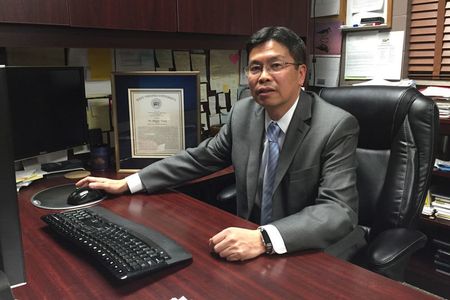
WVU's Jingxin Wang is researching ways to use logging's leftovers for biofuels, bioenergy, green electricity and value-added bioproducts.
MORGANTOWN, W.Va. -- Each year, more than 10 million dry tons of forest logging
residue is produced in the eastern United States.
According to a West Virginia University researcher, those residues are sustainable and can be used for biofuels, bioenergy, green electricity and value-added bioproducts which could spur rural economic development.
However, significant challenges exist when it comes to harvest and collection.
To address those challenges, Jingxin Wang, professor of wood science and technology in the Davis College of Agriculture, Natural Resources and Design, will lead a team of researchers in developing and optimizing forest logging residue harvest and collection logistics in the eastern United States.
The $1 million project is funded through the Agriculture and Food Research Initiative Competitive Grants Program administered by the USDA National Institute of Food and Agriculture. Wang will collaborate with researchers from Auburn University, Virginia Tech and the University of Maine.
Wood residue includes the waste left over from forest operations and management including tree tops, limbs and small diameter stems which would generally be left unused as wasted byproduct of traditional timber harvesting.
“The eastern U.S. has a wealth of forest resources and the potential to increase the forest logging residue supply for value-added bioenergy and bioproducts for both the near-term and long-term bioeconomic development,” Wang said. “The widespread availability of the logging residue resources provides a competitive advantage for rural economic development. Rural economies can benefit from both employment opportunities and economic investment along the forest residue supply chain including harvesting and collection crews, preprocessing, and bio-refinery conversion facilities.”
However, Wang indicated harvest, collection, and logistics of logging residue remain a challenge of the overall economics of biomass supply chains.
“Development of renewable biofuels and bioproducts, as a result, has been slow due to the lack of regional data and models on detailed and robust forest logging residue production and supply chain analysis, techno-economic analysis and life cycle analysis,” he said.
Those overarching challenges are compounded by regional differences in forest stand types, species composition, terrains and timber harvesting systems.
To create a comprehensive analysis, the researchers classified the eastern U.S. into four sub-regions: Northeast, Upper Mid-Atlantic, Lower Mid-Atlantic and Southeast.
The project will identify and improve methods to integrate forest residue collection into timber harvesting practices, ultimately improving efficiency and cost-effectiveness of residue collection with consideration of regional differences in species, terrain and harvesting systems.
“The field study of real cases will provide supportive evidence and strategic guidance to encourage the development of local businesses for forest logging residue utilization,” Wang said. “Ultimately, we want to create a supply chain capable of utilizing locally sourced feedstocks for renewable energy and products that will provide opportunities for rural economic development and growth.”
This project is supported by Agriculture and Food Research Initiative Grant #2019-67020-29287 from the U.S. Department of Agriculture National Institute of Food and Agriculture.
-WVU-
law/05/02/19
CONTACT: Lindsay Willey
Davis College of Agriculture, Natural Resources and Design
304.293.2381;
Lindsay.Willey@mail.wvu.edu
Follow @WVUToday on Twitter.